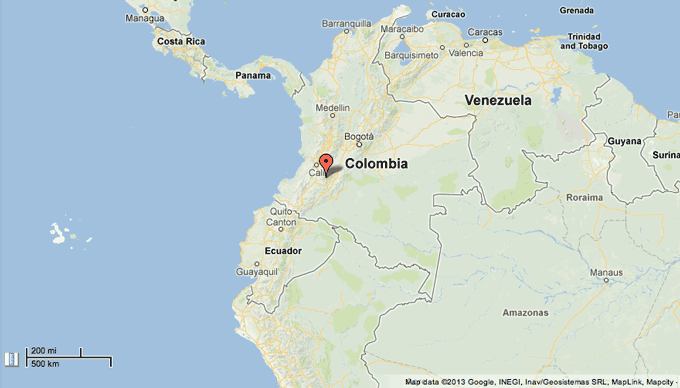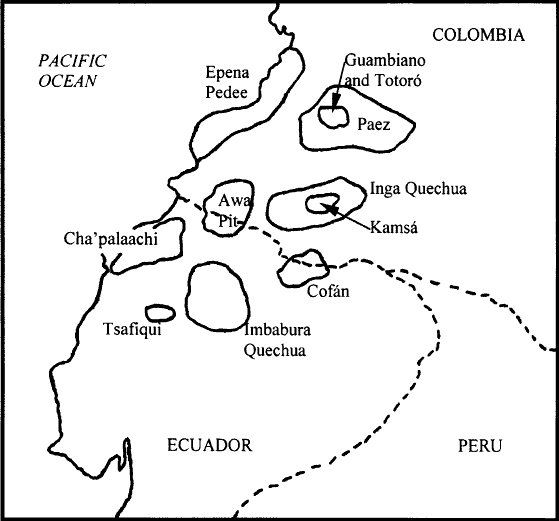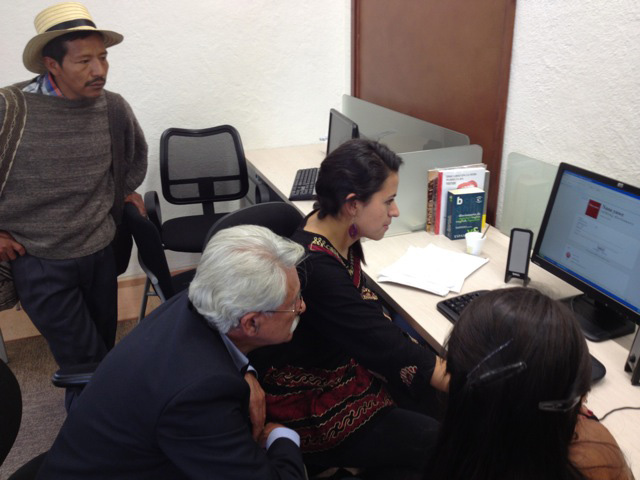About the Nasa Yuwe Talking Dictionary
Páez is an Amerindian language spoken in the central Andes range of Colombia near the city of Popayan in the department of Cauca. The Páez people call their language Nasa Yuwe, which means ‘language of the people’ in Páez. According to the Ethnologue, there are roughly 77,400 speakers of Páez, among them some 35-41,000 monolinguals.
 1. The Páez community is located in southwest Colombia (WALS coordinates: 2° 40′ N, 76° W from WALS Online, 2011)(Google Maps).
1. The Páez community is located in southwest Colombia (WALS coordinates: 2° 40′ N, 76° W from WALS Online, 2011)(Google Maps).
There is considerable controversy within the academic community surrounding the language’s classification. The most popular hypothesis suggests that Páez is a language isolate, and that any similarities to Guambiano (a Barbacoan language) or Macro-Chibchan languages are a result of language contact, and thus do not suggest that these languages belong to the same linguistic family (Fabre 2005). The two principal dialects of Páez are Paniquita (Panikita) and Pitayo. The Ethnologue defines Páez as a “threatened” language, meaning that intergenerational transmission is declining, but that the child-bearing generation can still use the language for face to face interaction. This suggests that revitalization efforts could restore transmission of the language in the home (Ethnologue 2013).
 2. Indigenous languages of Southwestern Colombia and Northwestern Ecuador (Constenla Umaña 1991: 70 as cited in Curnow 1998: 341).
2. Indigenous languages of Southwestern Colombia and Northwestern Ecuador (Constenla Umaña 1991: 70 as cited in Curnow 1998: 341).
Páez culture has traditionally valued orality above written literacy. It has been said that orality within the Páez community is a “basis for asserting a distinct ethnic identity” from Spanish (Rappaport 1987, p.45). The Páez people use written literacy in specific social junctures, such as the legal and political domains, but they reject literacy in other internal affairs, which helps them “maintain a degree of ideological autonomy” (Rappaport 1987, pp.57). Páez orthography uses a latin script.
 3. Páez (Nasa Yuwe) team members Prof. Pedro Marin Silva, Yesenia Rincón Jimenéz and Anania Piñuacue using the Nasa Yuwe talking dictionary at the workshop in Bogotá, 26 Oct. 2012. Photo by K. David Harrison.
3. Páez (Nasa Yuwe) team members Prof. Pedro Marin Silva, Yesenia Rincón Jimenéz and Anania Piñuacue using the Nasa Yuwe talking dictionary at the workshop in Bogotá, 26 Oct. 2012. Photo by K. David Harrison.
The initial recordings for this dictionary came from a Talking Dictionary Workshop taught by Dr. K. David Harrison as part of the 3rd annual “Festival de la Palabra” (Festival of Words) in honor of Colombia’s linguistic and cultural diversity, held at the Instituto Caro y Cuervo in Bogotá, Colombia, in October 2012. A print version of the Diccionario: páez-español / español-páez by Florence Gerdel and Marianna Slocum, will be used as a wordlist to elicit recordings by the Páez community as they work with Living Tongues to build an online talking dictionary.
We would like to thank all the Páez language consultants for their cooperation and contributions. The research for this dictionary was made possible by the support and assistance of the National Geographic Enduring Voices Project, the Living Tongues Institute for Endangered Languages, Swarthmore College and Instituto Caro Y Cuervo. All content is under copyright by the authors. Words and recordings remain the intellectual property of the speakers and community. Any questions or comments concerning this project can be sent to talkingdictionary@swarthmore.edu.
References and Further Reading:
Constenla Umana, Adolfo. (1991). Las Lenguas del Area Intermedia: Introducción a su Estudio Areal. San Jose: Editorial de la Universidad de Costa Rica
Curnow, T. J., & Liddicoat, A. J. (1998). The barbacoan languages of colombia and ecuador. Anthropological Linguistics, 40(3), 384-408. Retrieved from http://search.proquest.com/docview/85676515?accountid=9772
Curnow, Timothy Jowan. (1998). Why Paez is not a Barbacoan language: The nonexistence of “Moguex” and the use of early sources. International Journal of American Linguistics, Vol. 64, No. 4 (Oct., 1998), pp. 338-351. Retrieved from http://www.jstor.org/stable/1265907
Dryer, Matthew S. and the WALS author team. (2011). Language page for Páez. In: Haspelmath, Martin & Dryer, Matthew S. & Gil, David & Comrie, Bernard (eds.) The World Atlas of Language Structures Online. Munich: Max Planck Digital Library, chapter 39. Retrieved from http://wals.info/languoid/lect/wals_code_pae. Accessed on 2013-04-17.
Aspectos de la cultura material de grupos étnicos de colombia. tomo II. Instituto lingüístico de verano. Ministerio de Gobierno- República de Colombia. 2a edicíon retrived from http://www-01.sil.org/americas/colombia/pubs/15768.pdf
Ethnologue (2013). http://www.ethnologue.com/language/about/language-status http://www.ethnologue.com/language/pbb
Fabre, Alain. (2005). Diccionario etnolingüístico y guía bibliográfica de los pueblos indígenas sudamericanos NASA.
Gerdel, Florence L. and Marianna C. Slocum, authors. (1983). Diccionario: páez-español / español-páez. Lomalinda: Editorial Townsend. xxii, 493 pages. http://www.sil.org/americas/colombia/pubs/abstract.asp?id=928474519033
Living Tongues Institute for Endangered Languages. (2012). “Festival of Words” and Talking Dictionary Workshop in Colombia. Retrieved from: http://livingtongues.wordpress.com/2012/11/08/colombia/
Pittier, Henri. (1907). Ethnographic and Linguistic Notes on the Paez Indians of Tierra Adentro, Cauca, Colombia. Retrieved From: http://books.google.com/books?id=6HRsAAAAMAAJ
Rappaport, Joanne. (1987). Mythic Images, Historical Thought, and Printed Texts and the Paéz and the Written Word. Journal of Anthropological Research, Vol. 43, No. 1 (Spring. 1987, pp/ 43-61) Retrieved from http://www.jstor.org/stable/3630466
Ximena, Pachón C. and François Correa. (1997). Nasa Yuwe, or a Dominated Language´s Struggle for Survival. Lenguas amerindias: condiciones sociolingüísticas en Colombia.